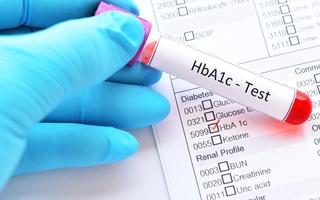How to test for prediabetes
How do you know that you have prediabetes? A blood test is used to diagnose prediabetes. The most commonly used test is called HbA1c. In the past an Oral Glucose Tolerance Test was used. In this article we discuss these blood tests and the levels that diagnose prediabetes.

Need to know
There are two ways to test for and diagnose prediabetes:
- HbA1c blood test
- Oral Glucose Tolerance Test (OGTT)
The HbA1c test is now the most used method.
Diagnosing prediabetes
There are two different blood tests that can diagnose prediabetes. The test that is most often used measures the HbA1c level in the blood. The other is called an Oral Glucose Tolerance Test, which is now rarely used due to it being a more complicated.
HbA1c
- HbA1c is now the most common method for diagnosing prediabetes.
- The HbA1c test gives an indication of the average blood glucose level over the previous 3 months.
- In the UK, a HbA1c of 42 to 47 mmol/mol is diagnostic for prediabetes.
HbA1c is short for “glycated haemoglobin”. In simple terms this measures how much glucose sugar is stuck to the haemoglobin in the red blood cells. Haemoglobin is the molecule inside red blood cells that carries oxygen around in the blood.
Glucose in the blood can be thought of as “sticky”. It will attach to lots of molecules in the body, including haemoglobin. More glucose in the blood means more glucose will stick to the haemoglobin. This will increase the amount of HbA1c in the blood.
Red blood cells are constantly being made in the body. They last about three months in the blood before being broken down and removed. Because of this the HbA1c blood test provides an indication of the average blood glucose level over the previous three months.
What do the HbA1c results mean?
- Normal is a HbA1c level of 41mmol/mol or less.
- Prediabetes is diagnosed with a HbA1c level of 42 to 47mmol/mol.
- Diabetes is diagnosed with a HbA1c level of 48mmol/mol or more.
Oral Glucose Tolerance Test
- An OGTT tests blood glucose after fasting, then again 2-hours after a drink containing 75g of glucose.
- A glucose level at 2 hours of 7.8 to 11.0 mmol/l is diagnostic of prediabetes.
- The OGTT is now rarely used because it is more complicated than testing for HbA1c.
Before the HbA1c test became commonly used an Oral Glucose Tolerance Test (OGTT) was the most reliable method for assessing the body’s ability to lower blood glucose. However, an OGTT is now only occasionally used due to the more complex procedure. The person must fast for eight hours, then have a blood test, followed by a glucose drink, sit for two hours, then have another blood test.
If the blood glucose level is above a certain level two hours after the sugary drink the person can be diagnosed with “impaired glucose tolerance” (which is similar to prediabetes) or diabetes.
What do the OGTT results mean?
- Normal is a blood glucose level at 2-hours of 7.7 mmol/l or less
- Impaired glucose tolerance, or prediabetes, is diagnosed if the blood glucose level at 2-hours is 7.8 to 11.0 mmol/l
- Diabetes is diagnosed if the blood glucose level at 2-hours is 11.1 mmol/l or more